
ZARP's from Johannesburg 1900 prior to departing for battle
Back to home Back to Historical
The
Van Rensburg's of Rensburg Siding, Colesberg, Cape part
1
The Anglo-Boer War Introduction
part 2
The Anglo-Boer War around
Rensburg Siding: Boer Leaders part 3
The Anglo-Boer War around
Rensburg Siding Nov 1899 part
4
The
Anglo-Boer War around Rensburg Siding Dec 1899 part
5
The Anglo-Boer War
around Rensburg Siding Jan 1900 part
6
The Anglo-Boer War around
Rensburg Siding Feb 1900 part 7
The
Anglo-Boer War in retrospect part
8
Australian units, persons and casualties part
9
MAIN
MAP source http://www.mjvn.co.za/anglo-boer/mainmap1.jpg
The Anglo-Boer War: Australians capture De Wet's artillery gun at Rensburgdrift part 10
Page 1 Page 2
The
Anglo-Boer War around Rensburg Siding
January 1900
When General French realised that General Schoeman (other sources also indicate
that Commandant Piet de Wet was amongst those who retreated) left Rensburg Siding,
he then on 30 December 1899 pursued the Boers with a force of 850 soldiers.
In addition also started bombing their dwellings in Colesberg. The Boer forces
then fired back, thereby revealing their position, and giving the information
French needed for his main attack on 1st January 1900.
Oorlogsdagboek van Jan F. E. Celliers 1899 - 1902, p. 50n; Die
geskiedenis van die Tweede Vryheidsoorlog in Suid-Afrika, 1899 -1902, IV,
pp. 30 - 31.
In Celliers' dagboek or diary, he writes about the daily bombardment
of Colesberg during January 1900. He also mentions that the minister of the
Dutch Reformed Church at Colesberg came to the camp to take a service, and when
the bombs started to explode he not even stopped preaching his sermon.

ZARP's from
Johannesburg 1900 prior to departing for battle
On 1st January 1900 the ZARP's arrived at Colesberg under the leadership of Commandant GMT Van Dam to reinforce General Schoeman.
According to Banjo, From the Front: A.B. (Banjo) Paterson's Dispatches from the Boer War, p. 81: the Lancers on 31 December went to Porter's Hill (named after Colonel TC Porter commander of the Carbineers). They waited for a few days and then were told to return to Rensburg Siding. Major Lee asked whether some of his men could stay behind and permission was given for Roberts and 8 Lancers to stay behind.
Between 1 January and 5 January 1900 there were engagement at Jasfontein, Plewmanhalte, Grassy Hill (Graskop), Skietfontein and Colesberg. During this time, on 1st January the Boers retired from Colesberg but on the 3rd they reoccupied Colesberg.
A major psychological plus for the Boers with train trucks
"In
the early hours of 2 January 1900 the Boers uncoupled 32 trucks at the railway
siding near the British camp at Rensburg Siding. The trucks ran down a long
incline for about 5 miles in the direction of Colesberg before coming to a halt
at Plewman [halte] near the Boer position. The Boers had blown up part of the
track and some of the trucks were derailed. A detachment of New South Wales
Lancers and Australian Horse under Captain Cox (Charles Frederick Cox was born
on 2 May 1863) was called out at 2.30 am to go after the trucks which were loaded
with stores. An engine also steamed down the line to bring the trucks back to
Rensburg." These trucks were abandoned since when they tried to retrieve
it they came under heavy fire. They found cover and when darkness arrived they
retreated". R.L. Wallace, The Australians at the Boer War,
p 102.
The equivalent of 22 000 rations fell in the Boer's hands.
At midnight on Monday night the Lancers were told that 2 or 3 trucks with supplies had run down from Rensburg Siding towards Plewman's Siding, near the range of the Boer guns. At 3 o'clock the Lancers had to sent out a patrol. This was led by Heron and JBN Osborne with 12 men. This was about 3 miles from Rensburg Siding. When they got there they discovered that 36 trucks had run down the line, while 20 trucks were still standing safely on the railway line. Beside them were another 16 piled up in a confused heap, with the content all over the ground. No one knew how the trucks started running down the line. It was later found the Boers had laid explosive on the line. The front trucks however kept going for another quarter mile. Thus there were two lots of trucks with some smashed trucks in between. The trucks had four days of supplies for the 4,000 men at Rensburg Siding and also for a similar amount of horses. Supplies of biscuit tins, demijohns of rum, and boxes of chocolate. Ominously there were no signs of the Boers. They then returned to camp.
Later in the day Cox and Dowling with 25 men went down again, but this time there were many Boers unloading the trucks. The English retreated when being shot at and subsequently had to heliograph a report back. Later on the rest of the squadron plus 100 infantry came to join them, plus an engine to see if the trucks could be recovered. The Boers fled and the Lancers advanced to the trucks. The Boers then started shooting with their big guns. Cox, Dowling and their men got cover under the trucks closest to the Boers. Major Lee and his men occupied the wrecked trucks, while Osborne with his troops were put on guard by the side of the line. For the most of five hours they were being fired at under the trucks. This was the first experience of the Australian Horse contingent under fire. Trooper Ford was wounded in the leg and Priddle was wounded in the face. That night they received instructions to retire and for the next three days the Boers were able to loot the train. Later some Boer POW made mention that two Boers were injured in this skirmish.
On the 9th January an officer of the Royal Engineers told Banjo that he wanted to go with the NSW Lancers to the trucks and get a photo. They went and he was able to get the photo he wanted.
"The stationmaster at Rensburg was afterwards court martialled for releasing the breaks and setting the train in motion. He was afterwards shot."
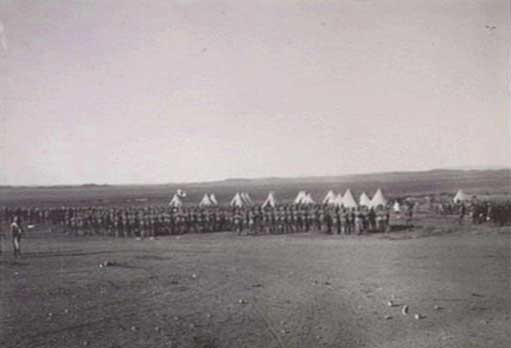
English soldiers
at Rensburg Siding, on church parade
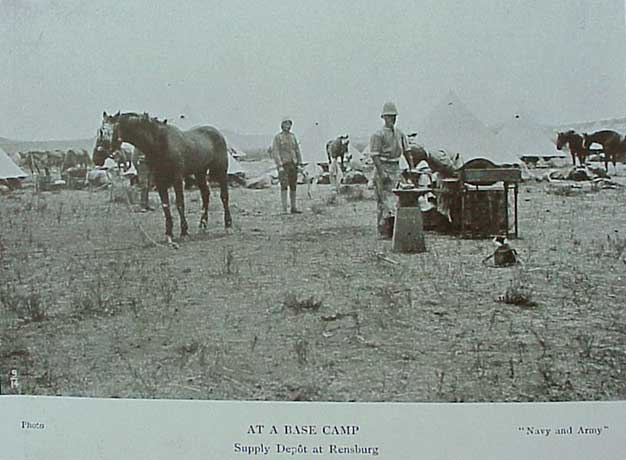
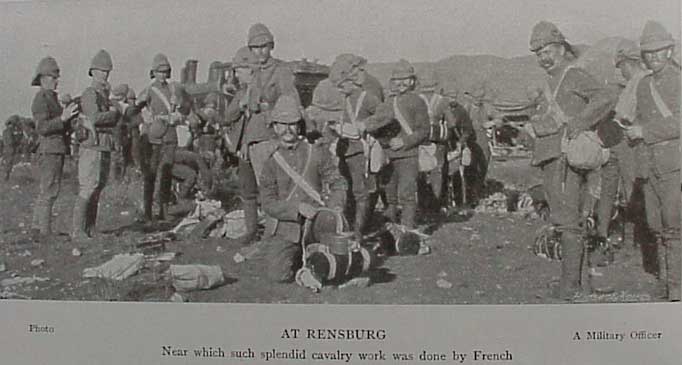
English forces
at Rensburg Siding notice the train in the background
On 4th January the British troops advanced from Maeders Farm to the outer circle
of hills around Colesberg - this includes Coleskop, McCracken Hill (Berkshires),
Porters Hill, Kloof Camp and Windmill Camp.
With Colonel Porter went the Carbineers, the New Zealanders MI,and some guns and a few Lancers. From Porters Hill they went to Coleskop and they launched an attack on the Boers on Gibraltar Kopje.
On
5th January the Boer positions around Colesberg were shelled by Artillery and
the English reconnoitred the area around Grassy Hill (Suffolk Hill) with the
idea of gaining possession of it the next day. French believed that the capture
of this hill would win Colesberg.
The Victoria Cross was awarded to Lieutenant Sir John P Millbanke (09.10.1872
- 21.08.1915) for his bravery on the Colesberg Front. On 5 Janaury while on
a reconnaissance they came under fire. One of the men was wounded and Milbanke
returned to rescue him. For his brave conduct he was awarded a VC. He was General
French's ADC (aide-de-camp, the French for 'adjudant'), he served with
the 10th Hussars. He got married to Leila Crichton in Dec 1901.
Look also at Suffolk Hill http://www.roll-of-honour.com/Regiments/BoerWarSuffolkHill.html
http://www.roll-of-honour.com/Cambridgeshire/BoerWarCambridge.html
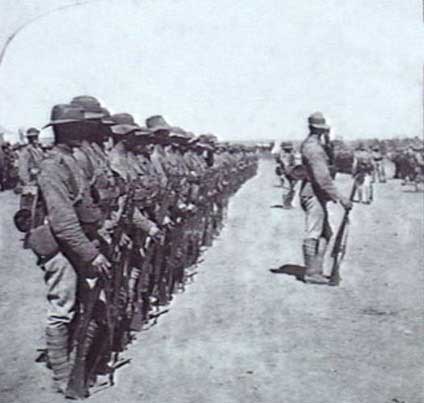
Australian Infantry,
at Naauwpoort ready to march north January 5, 1900
General French on the 6th January sent 200 soldiers to try and surprise 100 Boers from Heilbron at Coleskop.
Suffolk Hill (Red Hill) / Grassy Hill:
On
6th January near Coleskop, the 1st Suffolks Regiment were defeated
by the Boers:
The British Suffolks Regiment (400 men) under the leadership of Colonel
Watson left at 1:30 am and tried to attack the Boers on Rooikop (Red Hill) -
also known as Grassy Hill during the night - four miles to the north of Colesberg.
(These Boers served under Commandant Rooi Faans van Vuuren, present were also
the ZARP's). Half way up the hill they were ordered to fix their bayonets, and
then proceeded further in socks or sandshoes. The Boers however, were forewarned,
and when Major Graham shouted "charge" he was severely wounded. There
were lots of mayhem, not only caused by the Boer bullets, but also because the
English soldiers starting shooting one another. Officers, Brett, [ Lieutenant
Seymour James ] Carey, and Butler, was struck down. The imperial forces suffered
severely, with half of them being shot dead, including Colonel Watson. The Boers
carried the dead English down the hill and placed them ready for the ambulances
and clergyman to come and collect. Amazingly the Boers joined in singing a hymn
in respect to the English dead.
On the British side eleven officers and one hundred and fifty men lost their lives. (Out of 12 officers, four officers were killed, seven wounded, of which 6 were taken as prisoners). Another account gives the rank and file of the casualties: killed 36, wounded 52, missing or captured 72; being a total of 195 casualties. The only officer returning out of twelve was Major Graham, who was foremost in the fight and received three wounds. This Suffolk regiment was so decimated that the remainder were sent to Port Elizabeth to be re-equipped and be allotted new officers in command. This kopje and battle became known as Suffolks Hill.

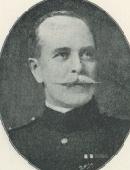
Colonel Arthur
John Watson was killed early in the charge of the 1st Suffolks, 6 January 1900
June 1853 - 1900
http://www.btinternet.com/%7Ecoghlan/deadwounded.htm#watson
http://redcoat.future.easyspace.com/BoerW.htm

Suffolks at
Colesberg
Banjo describes the Boer POW which came in a few days earlier: they "were very like a lot of bush labourers - hard-handed, sunburnt, bearded men, and they were thin, and starved looking. They said they had plenty of food in their camp, but had no time to cook it. They kept repeating, 'We are no soldiers, we are only farmers'." From the Front: A.B. (Banjo) Paterson's Dispatches from the Boer War, p 96, 97.
"The prisoners we took wept like children at the thought of being taken from their wives and families and homes, and they were quite sure they were going to be summarily shot." From the Front: A.B. (Banjo) Paterson's Dispatches from the Boer War, p. 103.
On 9th January 1900 Colonel TC Porter took the Carabiniers, New South Wales Lancers, New Zealanders, 4 guns of "O" Bty, 2 Coys. of the Yorkshires and a mounted section of the Royal Engineers, and occupied Slingersfontein east of Colesberg and established a Camp there.
It was also during this time that General French was ordered to go to Kimberley and his replacemet was Ralph Clements.
General
de la Rey arrived 11th January 1900:
Extra Boer forces arrived under General De la Rey and General Lemmer on 11th
January 1900 (some sources indicate 9th January) at Colesberg. Commandant GMJ
van Dam of the Johannesburg ZARP (Zuid Afrikaansche Republiek Politie) arrived
at the beginning of the month. De
le Rey was given a commando of his own, to begin with the Pretoria police (ZARPS)
under De Hart. De le Rey faced the enemy at Slingersfontein. On 22 January Piet
de Wet telegraphed the State President for more men. 400 men from Boshof and
Bethelehem was sent to to De la Rey which gave him a force of 1200. On 5 February
De le Rey with a section of the Johannesburg ZARPS under Oosthuizen, the Colesberg
burghers under Lategan (about 150 men) ans some Bloemfontein burghers towards
Naauwpoort. General Jan Celliers heading the Johannesburg police. On 13 February
De le Rey supported by H.R. Lemmer attacked Slingerfontein from the north-east.
Clements fled Slinerfontein leaving behind 100 tents, fodder and blankets, a
hand-Maxim and a heliogrpahic apparatus. Clements fell back to Rensburg station.
The English started to retreat to Arundel, as the Boers attacked Rietfontein
on the 20th

General Jacobus
Hercules (Koos) de la Rey (1847-1914),on the left and his staff
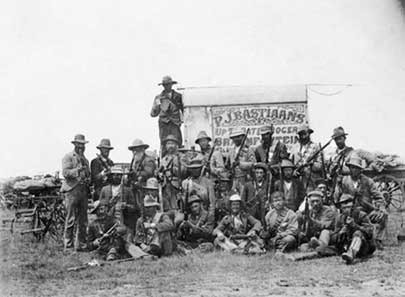
Some burghers
of General De la Rey in the Colesberg district

Boers of General De la Rey advancing on Colesberg
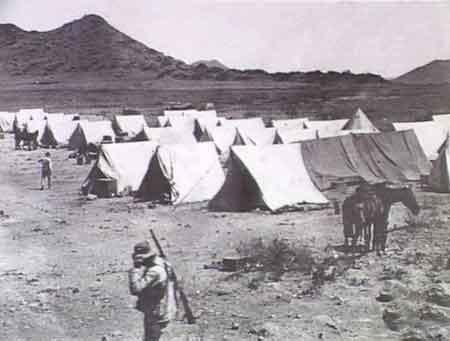
Boer ZARP Camp at Norvalspont
At
the request of President Steyn of the Free State, these units included the German
Commando under the command of Lieutenant Von Aldebyll. Part of the commando,
under the command of Fritz Brall, was detached to guard the bridge near Colesberg.
The field cornet of the detachment was C. Claus and the unit later formed the
nucleus of the Free State German Corps.
Page 2 Continued